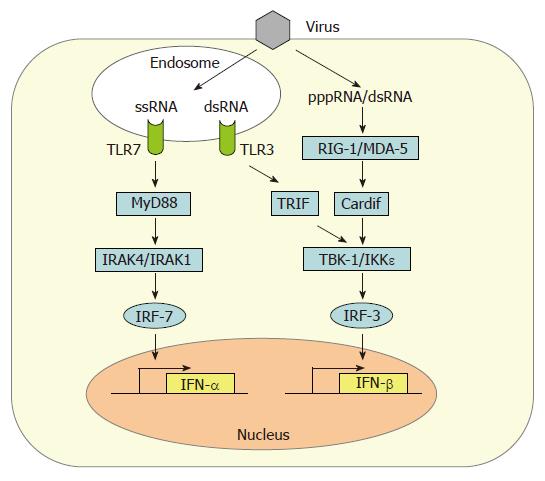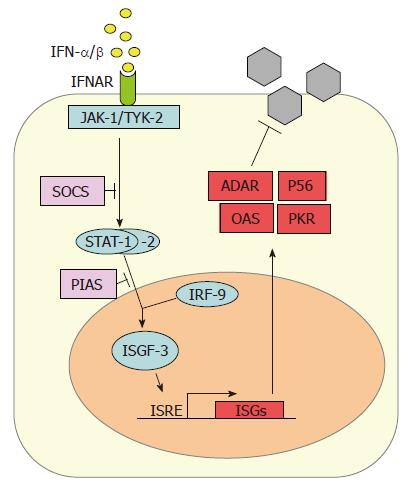Copyright
©2007 Baishideng Publishing Group Co.
World J Gastroenterol. Sep 28, 2007; 13(36): 4818-4823
Published online Sep 28, 2007. doi: 10.3748/wjg.v13.i36.4818
Published online Sep 28, 2007. doi: 10.3748/wjg.v13.i36.4818
Figure 1 Type I IFN gene expression.
Detection of viral ssRNA and dsRNA leads to transactivation of IFN-α and IFN-β promotors by IRF-7 and IRF-3. IRF-3 is phosphorylated by the kinases IKKε and TBK-1 which in turn are activated by the intracellular RNA-sensor proteins RIG-I and MDA5. RIG-I preferentially senses 5’triphosphorylated ssRNAs (pppRNA) whereas MDA-5 recognizes dsRNA. Cardif (also termed IPS-1/MAVS/VISA) serves as an adaptor protein connecting RNA sensing and IRF-3 phosphorylation. A second dsRNA signaling pathway involves endosomal TLR-3 and the adaptor protein TRIF which also activates IKKε and TBK-1. The endosomal ssRNA receptor TLR7 utilizes the adaptor protein MyD88 to stimulate IFN-α synthesis via the kinases IRAK4 and IRAK1 and the transcription factor IRF-7.
Figure 2 Cellular response to IFNs.
Newly synthesized IFN-α/β binds to its cognate receptor (IFNAR) and activates the expression of numerous IFN-stimulated genes (ISGs) via the JAK/STAT pathway. ADAR, P56, OAS and PKR are IFN-stimulated gene products with antiviral properties against HCV. The SOCS and PIAS proteins negatively regulate the IFN-induced signaling pathway at different stages.
- Citation: Weber F. Interaction of hepatitis C virus with the type I interferon system. World J Gastroenterol 2007; 13(36): 4818-4823
- URL: https://www.wjgnet.com/1007-9327/full/v13/i36/4818.htm
- DOI: https://dx.doi.org/10.3748/wjg.v13.i36.4818














